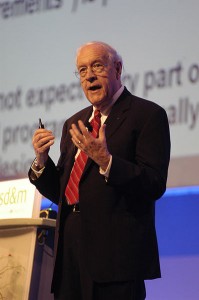Pioneering computer scientist Fred Brooks is the subject of an interesting Wired Q&A conducted by Kevin Kelly. Brooks became famous in the computer world–and beyond–for his book, The Mythical Man-Month, which gave lie to the idea that increased manpower translated into faster progress. The theory became known as Brooks’ Law.
Brooks has written a new book called The Design of Design: Essays From a Computer Scientist, which occasioned the interview. A few excerpts below:
•••••
Wired: How does a guy who grew up in the 1940s among North Carolina tobacco farmers get into computers?
Fred Brooks: I collected maps as a kid. I had tried all kinds of ways to index my map collection, which got me interested in the notion of automatic data retrieval. In 1944, when I was 13, I read about the Harvard Mark 1 computer in a magazine, and I knew then that computers was what I wanted to do.
•••••
Wired: You’re a Mac user. What have you learned from the design of Apple products?
Fred Brooks: Edwin Land, inventor of the Polaroid camera, once said that his method of design was to start with a vision of what you want and then, one by one, remove the technical obstacles until you have it. I think that’s what Steve Jobs does. He starts with a vision rather than a list of features.
•••••
Wired: You say that the Job Control Language you developed for the IBM 360 OS was “the worst computer programming language ever devised by anybody, anywhere.” Have you always been so frank with yourself?
Fred Brooks: You can learn more from failure than success. In failure you’re forced to find out what part did not work. But in success you can believe everything you did was great, when in fact some parts may not have worked at all. Failure forces you to face reality.
Tags: Fred Brooks, Kevin Kelly

